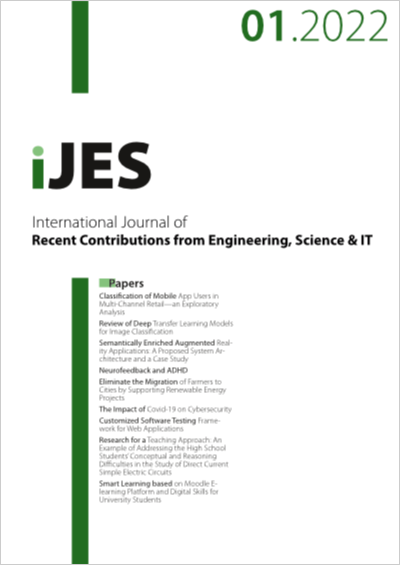Semantically Enriched Augmented Reality Applications: A Proposed System Architecture and a Case Study
DOI:
https://doi.org/10.3991/ijes.v10i01.27463Keywords:
Augmented reality, Cross reality, Deep learning, Human computer interaction, Immersive technologies, Mobile augmented reality, Machine learning, Semantic web, Extended reality, Case studyAbstract
With a view to creating a mixed reality that combines coexisting real and virtual objects and to providing users with real-time access to information in an interactive manner, augmented reality enriches users’ physical environment by incorporating digital and real objects and rendering them in the physical environment in the proper time and spatial framework. Due to its nature, augmented reality can be combined with and exploit other innovative technologies in order to improve its efficiency and potentials. Some such technologies are semantic web, knowledge graphs and deep learning. The study main purpose and contribution is to showcase the benefits of developing semantically enriched augmented reality applications and to present a system architecture for developing such applications as well as to showcase and assess an augmented reality application developed following the proposed architecture. The specific application aims at facilitating end-users’ day-to-day activities, enhancing the learning and informing process and increasing user experience (UX). The results of this study showcase that such applications have the potential to be applied and positively affect various sectors and that they can be a useful, flexible, interactive and informative tool for end-users.
Downloads
Published
How to Cite
Issue
Section
License
Copyright (c) 2022 Georgios Lampropoulos, Euclid Keramopoulos, Konstantinos Diamantaras

This work is licensed under a Creative Commons Attribution 4.0 International License.
The submitting author warrants that the submission is original and that she/he is the author of the submission together with the named co-authors; to the extend the submission incorporates text passages, figures, data or other material from the work of others, the submitting author has obtained any necessary permission.
Articles in this journal are published under the Creative Commons Attribution Licence (CC-BY What does this mean?). This is to get more legal certainty about what readers can do with published articles, and thus a wider dissemination and archiving, which in turn makes publishing with this journal more valuable for you, the authors.
By submitting an article the author grants to this journal the non-exclusive right to publish it. The author retains the copyright and the publishing rights for his article without any restrictions.
This journal has been awarded the SPARC Europe Seal for Open Access Journals (What's this?)


